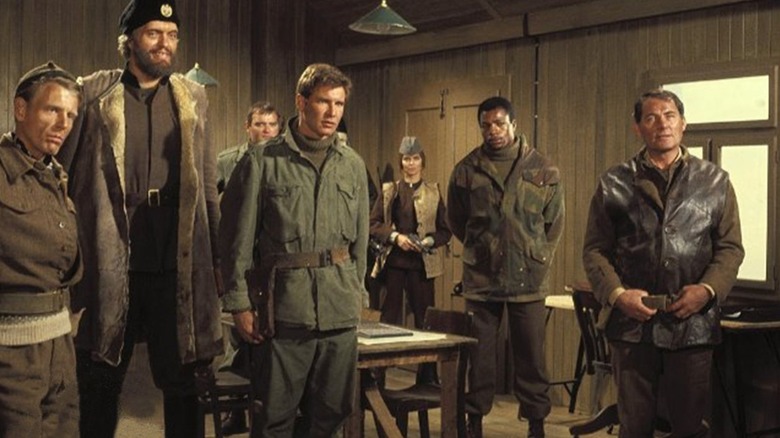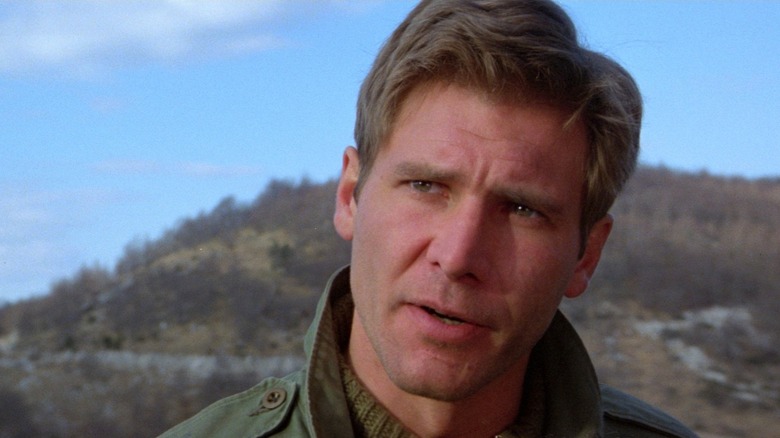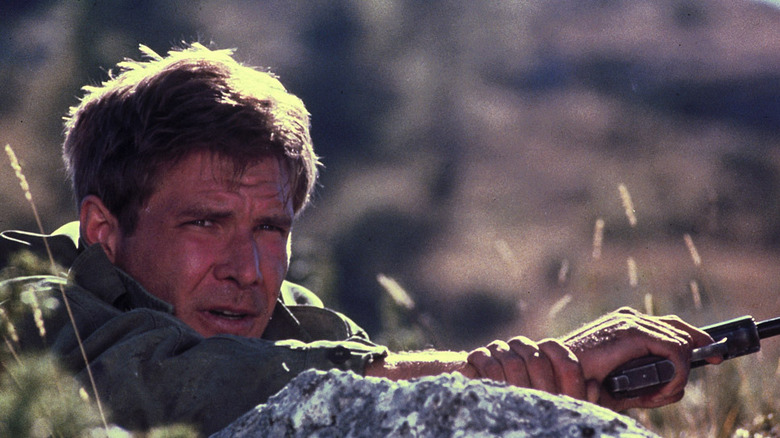The Harrison Ford Box Office Bomb That Inspired Star Wars: Rogue One
Gareth Edwards' 2016 nostalgia-fest "Rogue One: A Star Wars Story" seems to have been made to address what some people call a plot hole in George Lucas' 1977 film "Star Wars." In Lucas' film, the young Luke Skywalker (Mark Hamill) pilots a light attack craft up to a miniature hole in the exterior of the moon-sized Death Star, drops a bomb in it, and causes the entire superstructure to blow up. It is a satisfying ending to an exhilarating sci-fi pulp adventure.
Starwoids, however, watched Lucas films enough times that they began to ask questions. Why, the query went, would the deathly efficient Empire build a moon-sized planet-killing machine with such a grievous design flaw? Why build something so large and overpowered if a single bomb from a light attack craft can destroy it entirely?
The makers of "Rogue One" took that criticism to heart, and backward-engineered a story to explain the flaw. It seems that the designer of the Death Star was a kidnapped engineer, working under duress. He fundamentally disapproved of the Empire and of a Death Star, and deliberately designed it so that a single bomb could blow it up, should someone have the wherewithal to make the attempt. "Rogue One" is about a group of ragtag rebels who sacrifice their lives to learn and then communicate the above information to the Rebel Alliance.
It seems, however, that "Rogue One" wasn't merely spackling over a fan-noticed pseudo-error. According to Josh Kushin's 2016 book "The Art of Rogue One: A Star Wars Story," the characters in Edwards' film were designed after a little-seen 1978 clunker called "Force 10 From Navarone," a World War II movie starring Harrison Ford.
Don't feel bad if you don't know about "Force 10." It was a big bomb.
The Force 10 Awakens
Guy Hamilton's "Force 10 From Navarone" was a late-stage sequel to J. Lee Thompson's 1961 war picture "The Guns of Navarone." "Guns" is a fun, if clunky, men-on-a-mission movie about a scrappy group of allied soldiers on a secret mission to destroy a pair of massive Axis cannons located on the fictional island of Navarone. It starred Gregory Peck, David Niven, and Anthony Quinn.
"Force 10" replaced Peck and Niven with Robert Shaw and Edward Fox, and followed up on some loose ends from "Gun." Particularly, the soldiers from the first movie were betrayed by a secret Nazi agent, and it will become their mission in the sequel to track him down and kill him. The two leads team up with a cast of new characters, Harrison Ford among them. Ford was just coming off the success of "Star Wars," so "Force 10" might have felt like a step down in any circumstances.
It seems that any lingering fans of "Guns of Navarone" didn't leave the house to see a 17-years-later sequel, as "Force 10" made a paltry $3.2 million against its $10.5 million budget. It is not widely talked about anymore, with only deep-cut cineastes may bring it up in conversation.
One person who remembers "Force 10," however, was designer Christian Alzmann, noted for his work on "Rogue One," "Star Wars: Episode II – Attack of the Clones," and "A.I. Artificial Intelligence." In the "Art of Rogue One" book, he cited "Force 10" as a primary inspiration source, saying:
"If we go all the way back, it was very much like 'Force 10 from Navarone' – a ragtag commando team, which would allow us to play with a bunch of different character types and scales."
A side-by-side comparison of the films' respective casts reveals Alzmann's thinking.
Also 'Star Wars,' I guess
"Force 10" may have bombed because it opened opposite future Best Picture winner "The Deer Hunter," a bleak film that more accurately represented the public's attitudes about war in 1978.
Recall that "Rogue One" was also about a ragtag group of misfit soldiers. In addition to Ford, "Force 10" starred Barbara Bach, Richard Kiel, Carl Weathers, and Franco Nero, which is as ragtag a group of A-list actors as one might find in 1978.
"Rogue One" starred Felicity Jones as a neophyte Rebel, Diego Luna as an amoral fighter, Donnie Yen as a blind swordsman, Riz Ahmed as a fearful pilot, and Jiang Wen as a gun-toting badass. These are broad, WWII-movie archetypes that clearly drew inspiration from any number of man-on-a-mission movies. It was unusual that Alzmann called out "Force 10" by name.
And, of course, other designers looked to 1977's "Star Wars" as their primary visual template. "Rogue One" takes place immediately prior to "Star Wars," ending only seconds before the events of Lucas' film began. Concept artist Matt Allsop, who also worked on "Star Wars: The Force Awakens," noted the similarities and the notable colors he used, saying:
"You always have to look at 'Star Wars' — at the history of the universe — to see what's been done in the past, to make it all fit. [...] But another important part of 'Star Wars' is showing audiences something completely new. I quite like the blue-sky stuff."
The blue-sky stuff refers to a sequence late in "Rogue One" wherein the heroes storm an Empire stronghold located on a beachy, tropical planet. Planets in "Star Wars" are often noted for their unique, planet-wide biomes — swamp planet, forest planet, arctic planet, desert planet, etc. — and tropical biome hadn't been employed before.


